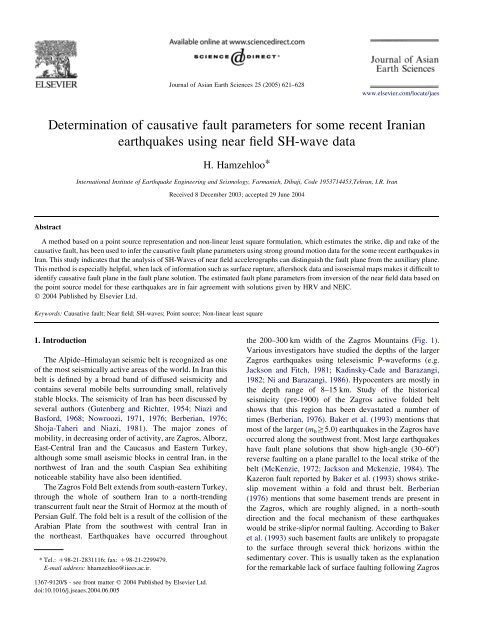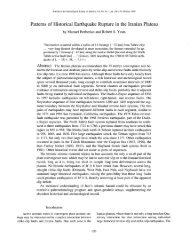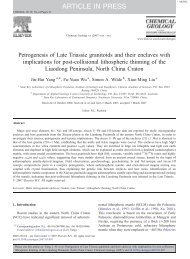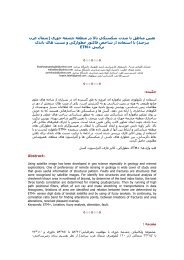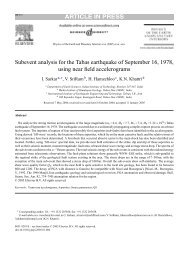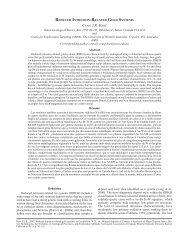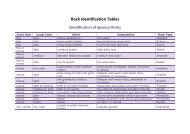Determination of causative fault parameters for some recent Iranian ...
Determination of causative fault parameters for some recent Iranian ...
Determination of causative fault parameters for some recent Iranian ...
Create successful ePaper yourself
Turn your PDF publications into a flip-book with our unique Google optimized e-Paper software.
Journal <strong>of</strong> Asian Earth Sciences 25 (2005) 621–628<br />
www.elsevier.com/locate/jaes<br />
<strong>Determination</strong> <strong>of</strong> <strong>causative</strong> <strong>fault</strong> <strong>parameters</strong> <strong>for</strong> <strong>some</strong> <strong>recent</strong> <strong>Iranian</strong><br />
earthquakes using near field SH-wave data<br />
H. Hamzehloo*<br />
International Institute <strong>of</strong> Earthquake Engineering and Seismology, Farmanieh, Dibaji, Code 1953714453,Tehran, I.R. Iran<br />
Received 8 December 2003; accepted 29 June 2004<br />
Abstract<br />
A method based on a point source representation and non-linear least square <strong>for</strong>mulation, which estimates the strike, dip and rake <strong>of</strong> the<br />
<strong>causative</strong> <strong>fault</strong>, has been used to infer the <strong>causative</strong> <strong>fault</strong> plane <strong>parameters</strong> using strong ground motion data <strong>for</strong> the <strong>some</strong> <strong>recent</strong> earthquakes in<br />
Iran. This study indicates that the analysis <strong>of</strong> SH-Waves <strong>of</strong> near field accelerographs can distinguish the <strong>fault</strong> plane from the auxiliary plane.<br />
This method is especially helpful, when lack <strong>of</strong> in<strong>for</strong>mation such as surface rupture, aftershock data and isoseismal maps makes it difficult to<br />
identify <strong>causative</strong> <strong>fault</strong> plane in the <strong>fault</strong> plane solution. The estimated <strong>fault</strong> plane <strong>parameters</strong> from inversion <strong>of</strong> the near field data based on<br />
the point source model <strong>for</strong> these earthquakes are in fair agreement with solutions given by HRV and NEIC.<br />
q 2004 Published by Elsevier Ltd.<br />
Keywords: Causative <strong>fault</strong>; Near field; SH-waves; Point source; Non-linear least square<br />
1. Introduction<br />
The Alpide–Himalayan seismic belt is recognized as one<br />
<strong>of</strong> the most seismically active areas <strong>of</strong> the world. In Iran this<br />
belt is defined by a broad band <strong>of</strong> diffused seismicity and<br />
contains several mobile belts surrounding small, relatively<br />
stable blocks. The seismicity <strong>of</strong> Iran has been discussed by<br />
several authors (Gutenberg and Richter, 1954; Niazi and<br />
Bas<strong>for</strong>d, 1968; Nowroozi, 1971, 1976; Berberian, 1976;<br />
Shoja-Taheri and Niazi, 1981). The major zones <strong>of</strong><br />
mobility, in decreasing order <strong>of</strong> activity, are Zagros, Alborz,<br />
East-Central Iran and the Caucasus and Eastern Turkey,<br />
although <strong>some</strong> small aseismic blocks in central Iran, in the<br />
northwest <strong>of</strong> Iran and the south Caspian Sea exhibiting<br />
noticeable stability have also been identified.<br />
The Zagros Fold Belt extends from south-eastern Turkey,<br />
through the whole <strong>of</strong> southern Iran to a north-trending<br />
transcurrent <strong>fault</strong> near the Strait <strong>of</strong> Hormoz at the mouth <strong>of</strong><br />
Persian Gulf. The fold belt is a result <strong>of</strong> the collision <strong>of</strong> the<br />
Arabian Plate from the southwest with central Iran in<br />
the northeast. Earthquakes have occurred throughout<br />
* Tel.: C98-21-2831116; fax: C98-21-2299479.<br />
E-mail address: hhamzehloo@iiees.ac.ir.<br />
the 200–300 km width <strong>of</strong> the Zagros Mountains (Fig. 1).<br />
Various investigators have studied the depths <strong>of</strong> the larger<br />
Zagros earthquakes using teleseismic P-wave<strong>for</strong>ms (e.g.<br />
Jackson and Fitch, 1981; Kadinsky-Cade and Barazangi,<br />
1982; Ni and Barazangi, 1986). Hypocenters are mostly in<br />
the depth range <strong>of</strong> 8–15 km. Study <strong>of</strong> the historical<br />
seismicity (pre-1900) <strong>of</strong> the Zagros active folded belt<br />
shows that this region has been devastated a number <strong>of</strong><br />
times (Berberian, 1976). Baker et al. (1993) mentions that<br />
most <strong>of</strong> the larger (m b R5.0) earthquakes in the Zagros have<br />
occurred along the southwest front. Most large earthquakes<br />
have <strong>fault</strong> plane solutions that show high-angle (30–608)<br />
reverse <strong>fault</strong>ing on a plane parallel to the local strike <strong>of</strong> the<br />
belt (McKenzie, 1972; Jackson and Mckenzie, 1984). The<br />
Kazeron <strong>fault</strong> reported by Baker et al. (1993) shows strikeslip<br />
movement within a fold and thrust belt. Berberian<br />
(1976) mentions that <strong>some</strong> basement trends are present in<br />
the Zagros, which are roughly aligned, in a north–south<br />
direction and the focal mechanism <strong>of</strong> these earthquakes<br />
would be strike-slip/or normal <strong>fault</strong>ing. According to Baker<br />
et al. (1993) such basement <strong>fault</strong>s are unlikely to propagate<br />
to the surface through several thick horizons within the<br />
sedimentary cover. This is usually taken as the explanation<br />
<strong>for</strong> the remarkable lack <strong>of</strong> surface <strong>fault</strong>ing following Zagros<br />
1367-9120/$ - see front matter q 2004 Published by Elsevier Ltd.<br />
doi:10.1016/j.jseaes.2004.06.005
622<br />
H. Hamzehloo / Journal <strong>of</strong> Asian Earth Sciences 25 (2005) 621–628<br />
Fig. 1. The HRV located epicenters <strong>for</strong> the 1994 Zanjiran, the 1997 Ardebil, the 1999 Kareh Bas, the 2002 Avaj, and the 2003 Jahrom earthquakes are shown<br />
with Stars. NTF: North Tabriz Fault; KF: Kazeron Fault.<br />
earthquakes <strong>of</strong> large magnitude (Berberian, 1976; Berberian<br />
and Papastamatiou, 1978; Jackson and Fitch, 1981;<br />
Ambraseys and Melville, 1982,). According to McKenzie<br />
(1972) interpretation <strong>of</strong> <strong>fault</strong> plane solutions in Zagros is<br />
hindered by the absence <strong>of</strong> observed surface ruptures.<br />
The pattern <strong>of</strong> seicmicity in the Alborz is discontinuous,<br />
with gaps filled in gradually by relatively large events. Most<br />
<strong>of</strong> the strong earthquakes are in the eastern and central<br />
Alborz regions. Considering macroseismic data, Ambraseys<br />
and Melville (1982) have found that the large scale<br />
seismicity <strong>of</strong> the region does not follow any pattern<br />
apparent from surface tectonics, nor is it dependent on the<br />
major known Quaternary <strong>fault</strong>s in the area. Recent large<br />
earthquakes occurring in this region suggest that the<br />
seicmicity is connected with relatively major <strong>fault</strong>s <strong>of</strong><br />
<strong>recent</strong> age that cut across the regional Quaternary<br />
lineaments.<br />
According to Berberian (1979), central Iran is not a linear<br />
seismic zone. It is characterized by scattered seismic<br />
activity with large magnitude earthquakes, long recurrence<br />
periods and seismic gaps along several Quaternary <strong>fault</strong>s<br />
(Fig. 1). The shocks in central Iran are generally shallow and<br />
are usually associated with surface <strong>fault</strong>ing. The Azarbaijan<br />
province in northwest Iran is bounded in the southwest by<br />
the north Tabriz Fault that has a northwest–southeast trend<br />
(Fig. 1). The northeast boundary is a major <strong>fault</strong> that<br />
separates this province from the Caspian shore province.<br />
The seismicity in this province is sporadic and does not<br />
show well-defined trends (Nowroozi, 1976). According to<br />
Ambraseys and Melville (1982), lack <strong>of</strong> earthquake<br />
in<strong>for</strong>mation <strong>for</strong> the Ardebil area suggests that no earthquakes<br />
<strong>of</strong> any significance have affected this area in the<br />
<strong>recent</strong> past. A study <strong>of</strong> historical earthquakes (pre-1900)<br />
shows that only a few earthquakes have occurred in this<br />
region.<br />
2. Method<br />
A <strong>fault</strong> plane solution yields in<strong>for</strong>mation about the nature<br />
<strong>of</strong> an earthquake. In addition, the usefulness <strong>of</strong> focal<br />
mechanism studies must be emphasized in its application to<br />
research on regional and global tectonics (Kasahara, 1981).<br />
A <strong>fault</strong> plane solution allows us to determine the mode <strong>of</strong><br />
stress change in the earth, at the specific time and locality <strong>of</strong><br />
an earthquake. The in<strong>for</strong>mation yielded by focal mechanism<br />
studies gives an instantaneous picture <strong>of</strong> tectonic movements.<br />
Several methods are available to estimate focal<br />
<strong>parameters</strong> such as first P-motion, S-waves, spectral<br />
amplitude <strong>of</strong> body wave, finite moving source, surface<br />
waves and moment tensor solution.<br />
Strong motion data play an important role in studying the<br />
nature <strong>of</strong> an earthquake. Strong motion recording close to
H. Hamzehloo / Journal <strong>of</strong> Asian Earth Sciences 25 (2005) 621–628 623<br />
Table 1<br />
Source <strong>parameters</strong> <strong>of</strong> selected earthquakes<br />
Earthquake Location <strong>of</strong> earthquake hypocenter M W NP1 NP2<br />
yy/mm/dd<br />
8N 8E km Str Dip Rake Str Dip Rake<br />
1994/6/20 29.06 52.44 15.0 5.9 251 67 K5 343 85 K157<br />
1997/2/28 38.30 48.06 15.0 6.1 184 57 K15 283 77 K146<br />
1999/5/06 29.34 52.03 17.4 6.2 52 76 K6 143 84 K165<br />
2002/6/22 35.85 48.94 16.8 6.5 304 26 110 102 66 80<br />
2003/7/10 28.41 54.02 15.0 5.6 305 42 118 91 49 66<br />
earthquake source gives more confidence in the estimation<br />
<strong>of</strong> the <strong>causative</strong> <strong>fault</strong>. The <strong>Iranian</strong> Strong ground motion<br />
network, which has been installed by the Building and<br />
Housing Research Center (BHRC), includes more than 1000<br />
strong ground motion stations in Iran. The availability <strong>of</strong><br />
strong ground motion data from <strong>Iranian</strong> earthquakes helps<br />
us to study earthquakes in more detail. The aim <strong>of</strong> this study<br />
is to infer the <strong>causative</strong> <strong>fault</strong> plane <strong>parameters</strong> using strong<br />
ground motion data, and show how these data can help us to<br />
identify the <strong>fault</strong> plane in the focal mechanism solution,<br />
especially when lack <strong>of</strong> in<strong>for</strong>mation such as surface rupture,<br />
aftershocks data, and an isoseismal map make it difficult to<br />
identify the <strong>fault</strong> plane in focal mechanisms reported by far<br />
field data. Recently, Sarkar et al. (2003) have analyzed the<br />
strong ground motion <strong>of</strong> the 1990 Rudbar earthquake to<br />
infer the characteristics <strong>of</strong> the source. SH-wave (horizontal<br />
shear wave) analyses <strong>of</strong> accelerograms exhibit distinct<br />
phases corresponding to energy released from three separate<br />
asperities on the discontinuous segments. The strike, dip,<br />
and rake <strong>for</strong> the three subevents have been estimated (Sarkar<br />
et al., 2003). The method <strong>of</strong> Sarkar et al. (2003) has been<br />
used to estimate the <strong>causative</strong> <strong>fault</strong> <strong>parameters</strong>. This method<br />
is based on a point source representation and non-linear<br />
least square <strong>for</strong>mulation which estimates the strike, dip and<br />
slip <strong>of</strong> the <strong>causative</strong> <strong>fault</strong> and a grid search technique that<br />
provides separate estimates <strong>of</strong> the strike, dip and slip. The<br />
analysis is confined to SH-waves because these are<br />
minimally affected by crustal heterogeneity (Haskell,<br />
1960). Corresponding theoretical estimates <strong>of</strong> SH-wave<br />
amplitudes <strong>of</strong> displacement are obtained from the <strong>for</strong>mulae<br />
<strong>for</strong> the radiation pattern <strong>of</strong> SH-waves in a full space (Aki<br />
and Richards, 1980; Lay and Wallace, 1995). The error<br />
function E (strike, dip, rake) is represented as:<br />
Eðstrike; dip; rakeÞ Z X i<br />
ðA oi KA ti Þ 2<br />
Here A oi and A ti denote the observed and theoretical<br />
amplitudes <strong>of</strong> the near field SH-wave displacement at the<br />
selected frequency at the ith station. The summation is over<br />
all stations that recorded the particular event. The non-linear<br />
Newton technique is used to obtain those values <strong>of</strong> strike,<br />
dip and rake which optimize E (strike, dip, rake) in the least<br />
square sense.<br />
To estimate <strong>causative</strong> <strong>fault</strong> plane <strong>parameters</strong>, near field<br />
strong ground motion data have been analysed <strong>for</strong> the 1994<br />
Zanjiran earthquake, the 1997 Ardebil earthquake, the 1999<br />
Kareh Bas earthquake, the 2002 Avaj earthquake and the<br />
2003 Jahrom earthquake. Location <strong>of</strong> these earthquake and<br />
their <strong>parameters</strong> are shown in Fig. 1 and Table 1.<br />
3. Data<br />
For this study, high quality reliable data, which show<br />
signal to noise ratio greater than 3, have been considered.<br />
Only data pertaining to the SH wave, are used. For<br />
appropriate selection <strong>of</strong> SH-wave components <strong>of</strong> the<br />
recorded data the radial (L) and transverse (T) components<br />
<strong>of</strong> recorded acceleration and displacement are suitably<br />
rotated so that corresponding estimates along and perpendicular<br />
to azimuth direction are obtained. The rotated<br />
transverse components provide acceleration and displacement<br />
data <strong>of</strong> SH-waves, recorded at each <strong>of</strong> station. The SHwave<br />
acelerogram records <strong>for</strong> the 1994 Zanjiran earthquke,<br />
the 1997 Ardebil earthquake, the 1999 Kareh Bas earthquake,<br />
the 2002 Avaj earthquake and the 2003 Jahrom<br />
earthquake are shown in Fig. 2.<br />
3.1. The 1994 Zanjiran earthquake<br />
On June 20, 1994, an earthquake with an estimated<br />
magnitude <strong>of</strong> M S 5.9, m b 5.9 occurred in the Firozabad<br />
region in Fars province, in south Iran in the Zagros<br />
Mountain Belt at 9:10:44 GMT (12:40:44 local time). The<br />
maximum intensity IX (modified Mercalli Intensity Scale)<br />
was reported in Zanjiran village. In spite <strong>of</strong> the vast<br />
destruction <strong>of</strong> buildings, the number <strong>of</strong> causalities and loss<br />
<strong>of</strong> life in this earthquake were very small. The earthquake<br />
killed three people and injured 120. Maximum acceleration<br />
<strong>of</strong> 10.98 and 10.04 m/s 2 <strong>for</strong> two horizontal components was<br />
recorded at Zanjiran station (Table 2). The SH-wave<br />
acelerogram records at Zanjiran, Zarat, Firozabad and<br />
Maimand are shown in Fig. 2.<br />
3.2. The 1999 Kareh Bas earthquake<br />
On May 6, 1999 an earthquake with estimated magnitude<br />
<strong>of</strong> M W 6.3 occurred near the Kareh Bas Fault (Fig. 3); 26<br />
people were killed and more than 1300 buildings<br />
were damaged. A maximum peak ground accelerations <strong>of</strong><br />
3.45 and 3.19 m/s 2 were recorded at the Dehballa station
624<br />
H. Hamzehloo / Journal <strong>of</strong> Asian Earth Sciences 25 (2005) 621–628<br />
Fig. 2. SH-wave accelerograms records from the 20 stations <strong>of</strong> the <strong>Iranian</strong> strong Ground motion array <strong>for</strong> the 1994 Zanjiran, the 1997 Ardebil, the 1999 Kareh<br />
Bas, the 2002 Avaj, and the 2003 Jahrom earthquakes. The silent Feature <strong>for</strong> each station is given in Table 2.
H. Hamzehloo / Journal <strong>of</strong> Asian Earth Sciences 25 (2005) 621–628 625<br />
Table 2<br />
Strong ground motion recording stations<br />
Earthquake Station Coordinate Horizontal peak ground acceleration<br />
(m/s 2 )<br />
8N 8E Elev. (m) Comp. L Comp. T<br />
1994/6/20 Firozabad 28.86 52.61 1325 2.55 2.79<br />
Maimand 28.87 52.75 1520 4.31 4.63<br />
Zanjiran 29.07 52.62 1690 10.04 10.93<br />
Zarat 29.10 52.30 1502 3.09 2.55<br />
1997/2/28 Ardebil 1 38.25 48.30 1360 1.56 1.21<br />
Ardebil 2 38.25 48.30 1360 1.64 1.20<br />
Astara 38.48 48.88 K19 0.42 0.37<br />
Namin 38.43 48.48 1450 0.67 0.96<br />
Razi 38.63 48.08 1420 0.31 0.43<br />
Sarab 37.94 47.53 1680 0.40 0.55<br />
1999/5/6 Dehballa 29.28 51.93 750 3.19 3.45<br />
Gavim 29.82 52.38 1800 0.38 0.33<br />
Khanzeynan 29.66 52.10 1909 1.56 1.23<br />
2002/6/22 Abegarm 35.75 49.28 1550 1.16 1.28<br />
Avaj 35.58 49.22 1970 4.55 4.29<br />
Abhar 36.15 49.22 1504 0.39 0.73<br />
Darsajin 36.03 49.23 1675 0.55 0.75<br />
Razan 35.38 49.03 1840 1.79 1.96<br />
2003/7/19 Hajiabad 28.35 54.42 1030 3.58 2.91<br />
Jouyom 28.25 53.98 840 0.70 0.43<br />
(Table 2). The SH-wave acelerogram records at Dehballa,<br />
Khanzeynun and Gavim are shown in Fig. 2.<br />
3.3. The 1997 Ardebil earthquake<br />
On February 28, 1997, an earthquake with an estimated<br />
magnitude <strong>of</strong> M S 6.1, m b 5.5 struck a highly populated area<br />
in northwest Iran at 12:57:12 GMT (16:27:12 local time).<br />
The earthquake killed more than 1200 people and destroyed<br />
12,000 buildings. The maximum intensity in Modified<br />
Mercalli Intensity Scale reported <strong>for</strong> this earthquake was<br />
VIII. Maximum accelerations <strong>of</strong> 1.56 and 1.21 m/s 2 <strong>for</strong> the<br />
two horizontal components were recorded at Ardebil station<br />
(Table 2). The SH-wave accelerogram records at Ardebil 1,<br />
Ardebil 2, Astara, Namin, Razi and Sarab are shown in<br />
(Fig. 2 and 4).<br />
3.4. The 2002 Avaj earthquake<br />
On June 22, 2002, a major earthquake, with an estimated<br />
magnitude <strong>of</strong> M W 6.5, occurred near Avaj (250 km west <strong>of</strong><br />
Fig. 3. Fault plane solutions <strong>for</strong> the 1994 Zanjiran, the 1999 Kareh-Bas, and the 2003 Jahrom earthquakes given by HRV (gray) and this study (black).
626<br />
H. Hamzehloo / Journal <strong>of</strong> Asian Earth Sciences 25 (2005) 621–628<br />
Fig. 4. The <strong>fault</strong> plane solutions <strong>of</strong> the 1997 Ardebil earthquake given by HRV (gray) and this study (black).<br />
Tehran) in NW Iran at 2:58:27.2 (GMT) (7: 28: 00 local<br />
time). The earthquake killed over 226 people and injured<br />
more than 1300. The earthquake was felt at Tehran and<br />
affected 373 villages in Ghazvin, Hamedan, Zanjan, and<br />
Markazi provinces. Maximum accelerations <strong>of</strong> 4.29<br />
and 4.55 m/s 2 <strong>for</strong> the two horizontal components were<br />
recorded at Avaj station (Table 2). The SH-wave accelerogram<br />
records at Abegarm, Abhar, Avaj, Darsajin and<br />
Razan are shown in Fig. 2.<br />
3.5. The 2003 Jahrom earthquake<br />
An earthquake with an estimated magnitude <strong>of</strong> M W 5.6<br />
occurred on July 10, 2003 at 17:6:37 (GMT) in the Zagros<br />
Mountains southeast <strong>of</strong> Jahrom in Fars province (Fig. 3).<br />
The earthquake killed one person and injured 25. Maximum<br />
peak ground accelerations <strong>of</strong> 3.58 and 2.91 m/s 2 <strong>for</strong><br />
two horizontal components were recorded at Hajiabad.<br />
The SH-wave acelerogram records at Hajiabad and Jouyom<br />
are shown in Fig. 2.<br />
4. Results<br />
The estimated <strong>causative</strong> <strong>fault</strong> <strong>parameters</strong> using SH-wave<br />
data <strong>of</strong> recorded accelerographs <strong>for</strong> the 1994 Zanjiran earthquke,<br />
the 1997 Ardebil earthquake, the 1999 Kareh Bas<br />
earthquake, the 2002 Avaj earthquake and the 2003 Jahrom<br />
earthquake are given in Table 3. The estimated strike, dip<br />
and rake <strong>for</strong> the the 1994 Zanjiran earthquake using analyses<br />
<strong>of</strong> SH-wave are 3358, 888 and K1368, respectively.<br />
These values <strong>for</strong> the 1999 Kareh-Bas are estimated as<br />
strikeZ1458, dipZ878 and rakeZK1608, respectively. For<br />
the 1997 Ardebil earthquake the values <strong>of</strong> strike, dip and<br />
rake are estimated as 1878, 858 and K108, respectively.<br />
The <strong>fault</strong> <strong>parameters</strong> <strong>for</strong> the 2002 Avaj earthquake are<br />
estimated as strikeZ1188, dipZ538, and rakeZ828, respectively.<br />
These values <strong>for</strong> the <strong>causative</strong> <strong>fault</strong> <strong>of</strong> the 2003 Jahrom<br />
earthquake are strikeZ3008, dipZ428 and rakeZ1188.<br />
5. Discussion<br />
5.1. The 1994 Zanjiran and the 1999 Kareh-Bas<br />
earthquakes<br />
The Harvard Centroid Moment Tensor (CMT) solution<br />
gives values <strong>of</strong> strike, dip and rake <strong>for</strong> the 1994 Zanjiran<br />
earthquake as 3438, 858, and K1578, respectively, while<br />
the NEIC suggest values 3558, 608 and K1798 <strong>for</strong> strike,<br />
dip and rake, respectively. It is observed that the values <strong>of</strong><br />
strikeZ3358, and dipZ888 from this study are in fair<br />
Table 3<br />
Estimated <strong>fault</strong> plane <strong>parameters</strong> using SH-wave analyses<br />
Earthquake NP1<br />
NP2<br />
yy/mm/dd<br />
Str Dip Rake Str Dip Rake<br />
1994/6/20 335 88 K136 243 46 K3<br />
1997/2/28 187 85 K10 278 80 K175<br />
1999/5/06 145 87 K160 54 70 K3<br />
2002/6/22 303 37 94 118 53 82<br />
2003/7/19 300 42 118 84 54 67
H. Hamzehloo / Journal <strong>of</strong> Asian Earth Sciences 25 (2005) 621–628 627<br />
agreement with strike and dip reported by Harvard (HRV)<br />
and National Earthquake In<strong>for</strong>mation Center (NEIC). The<br />
estimated rake <strong>of</strong> K1368 is close to the HRV than the<br />
NEIC estimates. The focal mechanism, which was obtained<br />
from analysis <strong>of</strong> SH-waves, shows right-lateral strike slip<br />
motion.<br />
Fault plane <strong>parameters</strong>, estimated <strong>for</strong> the <strong>causative</strong> <strong>fault</strong><br />
<strong>of</strong> the 1999 Kareh Bas earthquake, using analysis <strong>of</strong><br />
SH-waves, are 1458, 878 and K1608, respectively. The<br />
estimated strike, dip and rake, as given by HRV, are 1438,<br />
848, and K1658, respectively. The NEIC values <strong>for</strong> strike,<br />
dip and rake are 1358,868 and K1798, respectively. Again a<br />
fair agreement is observed between HRV estimates and<br />
results obtained from analysis <strong>of</strong> SH-wave <strong>for</strong> strike, dip<br />
and rake. The estimated rake is close to the HRV than the<br />
NEIC estimates. A right-lateral strike slip mechanism is<br />
observed from analysis <strong>of</strong> SH-wave.<br />
The solutions <strong>for</strong> the 1994 Zanjiran and the 1999 Kareh<br />
Bas earthquakes are in agreement with directions <strong>of</strong><br />
basement <strong>fault</strong>s in the Zagros, which are aligned roughly<br />
in a N–S direction (Fig. 3). Berberian (1976) concluded that<br />
the focal mechanisms <strong>of</strong> these earthquakes would be strikeslip/<br />
or normal <strong>fault</strong>ing. The strike-slip motions on the<br />
Kareh-Bas Fault and the <strong>causative</strong> <strong>fault</strong> <strong>for</strong> the Zanjiran<br />
earthquake show strike-slip movement within a fold and<br />
thrust belt. Strike-slip motion has been also reported by<br />
Baker et al. (1993) on the Kazeron Fault.<br />
5.2. The 1997 Ardebil earthquake<br />
The estimated values <strong>of</strong> strikeZ1878, dipZ858, and<br />
rakeZK108 from analysis <strong>of</strong> SH-wave are in fair agreement<br />
with strike and dip reported by HRV and NEIC. The<br />
Harvard Centroid Moment Tensor solution suggests values<br />
<strong>of</strong> strike, dip and rake <strong>for</strong> the 1997 Ardebil earthquake as<br />
1848, 578, and K158, respectively, while the NEIC suggest<br />
values <strong>of</strong> 1828, 7608 and 178 <strong>for</strong> strike, dip and rake,<br />
respectively. The focal mechanism, which was obtained<br />
from the analysis <strong>of</strong> SH-waves, shows strike-slip motion <strong>for</strong><br />
the 1997 Ardebil earthquake.<br />
5.3. The 2002 Avaj earthquake<br />
The estimated strike, dip and rake from near field data are<br />
1188, 538, and 828, respectively. NEIC and HRV have<br />
analyzed far field broadband data to provide estimate <strong>of</strong> the<br />
strike, dip and rake <strong>for</strong> the 2002 Avaj earthquake. NEIC<br />
suggest a strike, dip and rake <strong>of</strong> 1178, 528, and 1018, while<br />
the HRV gives values <strong>of</strong> 1028, 668, and 808 <strong>for</strong> strike, dip<br />
and rake, respectively. It is noticed that the value <strong>of</strong> strike,<br />
dip and rake from these two studies are in fair agreement<br />
with the estimated strike, dip and rake from analysis <strong>of</strong> SH<br />
waves <strong>of</strong> recorded near field data. The analyzes <strong>of</strong> SHwaves<br />
suggest a reverse mechanism with left-lateral<br />
component dipping toward SW.<br />
Fig. 5. The <strong>fault</strong> plane solutions <strong>of</strong> the 2002 Avaj earthquake given by HRV (gray) and this study (black). The <strong>fault</strong> plane solution <strong>of</strong> the 1962 Buin-Zahra<br />
earthquake is also shown.
628<br />
H. Hamzehloo / Journal <strong>of</strong> Asian Earth Sciences 25 (2005) 621–628<br />
These results are in agreement with tectonic situation in<br />
this area. First, the Ipak Fault, which was responsible <strong>for</strong> the<br />
1962 Buin-Zahra earthquake, has a reverse mechanism with<br />
left-lateral component (Fig. 5) dipping toward the southwest<br />
(Hessami et al., 2003). Secondly, the Soltanieh Fault shows<br />
a dip toward the southwest (Fig. 5). Also, the 2002<br />
Avaj earthquake, which occurred between the Ipak and<br />
Soltanieh <strong>fault</strong>s show reverse motion with dip toward the<br />
southwest.<br />
5.4. The 2003 Jahrom earthquake<br />
The Harvard Centroid Moment Tensor (CMT) solution<br />
suggest values <strong>of</strong> strike, dip and rake <strong>for</strong> the 2003 Jahrom<br />
earthquake <strong>of</strong> 3058,428, and 1188, respectively, while NEIC<br />
suggest strikeZ2988, dipZ478 and rakeZ1158. It is<br />
observed that the values <strong>of</strong> strikeZ3008, dipZ428 and<br />
rakeZ1188 from this study are in fair agreement with HRV<br />
and NEIC estimates. The focal mechanism, which was<br />
obtained from analysis <strong>of</strong> SH-waves, shows reverse motion.<br />
The <strong>fault</strong> plane solution <strong>of</strong> the 2003 Jahrom earthquake<br />
shows reverse <strong>fault</strong>ing parallel to the local strike <strong>of</strong> the belt<br />
and dipping towards north.<br />
6. Conclusions<br />
On the basis <strong>of</strong> analysis <strong>of</strong> SH-wave data <strong>for</strong> the 1994<br />
Zanjiran, the 1997 Ardebil, the 1999 Kareh Bas, the 2002<br />
Avaj, the 2003 Jahrom earthquakes the following conclusions<br />
have emerged:<br />
1. The SH-Waves analysis <strong>of</strong> near field accelerographs<br />
can distinguish the <strong>fault</strong> plane from the auxiliary<br />
plane. This method is especially helpful, when the<br />
lack <strong>of</strong> in<strong>for</strong>mation such as surface rupture, aftershocks<br />
data and an isoseismal map make it difficult to<br />
identify the <strong>causative</strong> <strong>fault</strong> plane in the HRV or NEIC<br />
solutions.<br />
2. The 1994 Zanjiran and the 1999 Kareh Bas earthquakes<br />
show strike-slip motion with a approximately north–<br />
south strike direction, which confirms the presence <strong>of</strong><br />
strike-slip motion in a folded and thrust belt. While the<br />
2003 Jahrom earthquake shows reverse motion with the<br />
<strong>fault</strong> plane parallel to the local strike <strong>of</strong> the belt and<br />
dipping towards the north.<br />
3. The 1997 Ardebil earthquake shows strike-slip motion<br />
with an approximately north–south strike.<br />
4. The 2002 Avaj earthquake shows reverse mechanism<br />
with a <strong>fault</strong> plane dipping towards the southwest, which<br />
is similar to the 1962 Buin-Zahra earthquake.<br />
5. The estimated <strong>fault</strong> plane <strong>parameters</strong> from inversion <strong>of</strong><br />
the near field data based on the point source model <strong>for</strong><br />
these earthquakes are in fair agreement with solutions<br />
given by HRV and NEIC.<br />
Acknowledgements<br />
I am grateful to International Institute <strong>of</strong> Earthquake<br />
Engineering, and Seismology <strong>for</strong> supporting this research<br />
work and Building and Housing Research Center, Tehran,<br />
I.R. Iran <strong>for</strong> providing the strong ground motion data. I am<br />
thankful to Dr John Milsom and Dr A.J. Barber <strong>for</strong> their<br />
constructive comments on the manuscript.<br />
References<br />
Aki, K., Richards, P.G., 1980. Quantitative Seismology: Theory and<br />
Methods, vol. 1. W.H.Freeman and Co, San Francisco.<br />
Ambraseys, N.N., Melville, C.P., 1982, A., 1982. History <strong>of</strong> Persian<br />
Earthquakes. Cambridge University Press, London.<br />
Baker, C., Jackson, J., Priestley, K., 1993. Earthquakes on Kazerun line in<br />
the Zagros mountains <strong>of</strong> Iran: strike-slip <strong>fault</strong>ing within a folded-andthrust<br />
belt. Geophysical Journal International 115, 41–61.<br />
Berberian, M., 1976. Contribution to the seismotectonics <strong>of</strong> Iran (Part II).<br />
Geological Survey <strong>of</strong> Iran, Report No. 39 1976;.<br />
Berberian, M., 1979. Earthquake <strong>fault</strong>ing and bedding thrust associated<br />
with the Tabas-E-Golshan (Iran) earthquake <strong>of</strong> September 16, 1978.<br />
Bulletin Seismological Society <strong>of</strong> America 69, 1861–1887.<br />
Berberian, M., Papastamatiou, D., 1978. Khurgu (north Bandar Abbas,<br />
Iran) earthquake <strong>of</strong> March 21, 1977: a preliminary field report and<br />
seismotectonic discussion. Bulletin Seismological Society <strong>of</strong> America<br />
68, 411–428.<br />
Gutenberg, B., Richter, C.F., 1954. Seismicity <strong>of</strong> the Earth and Associated<br />
Phenomena. Princeton University Press, Princeton, NJ.<br />
Haskell, N.A., 1960. Crustal reflection <strong>of</strong> plane SH waves. Journal <strong>of</strong><br />
Geophysical Research 65, 4147–4150.<br />
Hessami, H., Jamali, F., Tabassi, H., 2003. Major active Faults <strong>of</strong> Iran,<br />
Scate 1:2,500,000, International Institute <strong>of</strong> earthquake engineering and<br />
Seismology.<br />
Jackson, J., Fitch, T., 1981. Basement <strong>fault</strong>ing and the focal depth <strong>of</strong> the<br />
large earthquakes in the Zagros mountains (Iran). Geophysical Journal<br />
Research Astronomy Society 64, 561–586.<br />
Jackson, J., Mckenzie, D.P., 1984. Active tectonics <strong>of</strong> the Alpine-<br />
Himalayan Belt between western Turkey and Pakistan. Geophysics<br />
Journal Research Astronomy Society 77, 185–264.<br />
Kadinsky-Cade, K., Barazangi, M., 1982. Seismotectonics <strong>of</strong> southern Iran:<br />
the Oman line. Tectonics 1, 389–412.<br />
Kasahara, K., 1981. Earthquake Mechanics Cambridge Earth Sciences<br />
Series. Cambridge University Press, Cambridge.<br />
Lay, T., Wallace, T.C., 1995. Modern Global Seismology. Academic Press.<br />
McKenzie, D., 1972. Active tectonics <strong>of</strong> the Mediterranean region.<br />
Geophysical Journal Research Astronomy Society 30, 109–185.<br />
Niazi, M., Bas<strong>for</strong>d, J.R., 1968. Seismicity <strong>of</strong> <strong>Iranian</strong> plateau and Hindukush<br />
region. Bulletin Seismological Society <strong>of</strong> America 58, 417–426.<br />
Ni, J., Barazangi, M., 1986. Seismotectonics <strong>of</strong> the Zagros continental<br />
collision zone and comparison with the Himalayas. Journal <strong>of</strong><br />
Geophysical Research 91, 8205–8218.<br />
Nowroozi, A.A., 1971. Seismo-Tectonics <strong>of</strong> the Persian plateau, Eastern<br />
Turkey, Caucasus, and Hindu-Kush regions. Bulletin Seismological<br />
Society <strong>of</strong> America 61, 317–341.<br />
Nowroozi, A.A., 1976. Seismotectonic provinces <strong>of</strong> Iran. Bulletin<br />
Seismological Society <strong>of</strong> America 66, 1249–1276.<br />
Sarkar, I., Hamzehloo, H., Khattri, K.N., 2003. Estimation <strong>of</strong> <strong>causative</strong><br />
<strong>fault</strong> Parameters <strong>of</strong> the Rudbar earthquake <strong>of</strong> June 20, 1990 from near<br />
field SH-wave Data. Tectonophysics 364, 55–70.<br />
Shoja-Taheri, J., Niazi, M., 1981. Seismicity <strong>of</strong> the <strong>Iranian</strong> plateau and<br />
bordering regions. Bulletin Seismological Society <strong>of</strong> America 71, 477–489.


